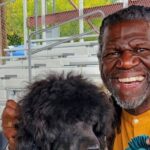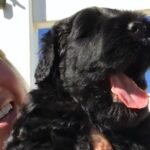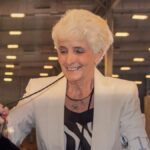Interview with Debra Gschwender, Breeder of Jasm Bouvier des Flandres
Please tell us a little bit about yourself. Where do you live? What is your breed? What is your kennel name? Do you have a website? How long have you been in dogs? How long have you been breeding dogs? Who are some of your best-known dogs?
Debra Gschwender: I live in Nampa, Idaho. I have been in Bouvier des Flandres since 1982. My original kennel name was Rendezvous, but for the last 30 years I have been co-breeding with Joyce Vaughn under the Jasm kennel name. I started in the AKC dog world when I was 16 years old, putting a CD on my Rough Collie.
Some of my most memorable dogs were/are: CH Rendezvous Ijs vh Grendarcof, whom I imported from the Netherlands at eight weeks of age; CH Rendezvous Cover Girl; CH Jasm’s Cowboy Up; and most recently, the dog we bred that won the National Specialty, Multiple BISS GCH Jasm’s Light Up The Night.
As a Breeder, can you share your thoughts on your breed today? Is breed type strong? Are there things to be concerned about? Are there any health-related issues? Have you worked with breeders overseas? Are pet homes typically available for your breed?
Debra Gschwender: The Bouvier des Flandres has changed a great deal in 40 years. I think most breeders are doing health testing now. We usually don’t have any problems finding pet homes.
I see some improvement in breed type, but I still see some serious problems: dogs with straight shoulders and over-angulated rears (still); dogs that are long (in body and, most problematically, in the loin); and wooly coats. I’m not sure if the coats are wooly because the exhibitors don’t know how to groom or they are just breeding dogs with wooly coats because they can scissor instead of strip.
As an Exhibitor, can you comment on recent entries in your breed? Are majors available in your area? Does your breed often participate in Companion and Performance events? How can newcomers in your breed be encouraged to join the sport of dogs?
Debra Gschwender: As an exhibitor, majors are not always easy to find. Our breed just came off the low entry list. The Bouvier des Flandres is a very versatile breed, and many owners compete in multiple venues; Agilty, Scent Work, Obedience & Rally, Carting—they excel in all.
Newcomers in our breed, as in any breed, need good mentors, and they need to be willing to listen and learn.
I think one of the biggest challenges to the dog show community is getting younger people involved, both in showing dogs and joining clubs. Many all-breed clubs are “aging out” and that’s sad. We need to be more encouraging and have more education for newcomers. In my early days of showing, it was more social, with more camaraderie.
What are the biggest challenges facing the dog show community as a whole and how can we address them? And finally, what are some of the positive changes you’ve seen in your breed and in the dog show community as a whole over the past decade?
Debra Gschwender: I think one of the biggest challenges to the dog show community is getting younger people involved, both in showing dogs and joining clubs. Many all-breed clubs are “aging out” and that’s sad. We need to be more encouraging and have more education for newcomers. In my early days of showing, it was more social, with more camaraderie. You showed your dog, but you stayed to the end and visited with other breeders and other breeds. Nowadays, it seems people show their dogs and don’t even stay to watch the end of their Breed judging. I am encouraged with more clubs and AKC encouraging the Junior Showmanship program.








